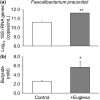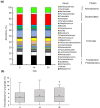The alga Euglena gracilis stimulates Faecalibacterium in the gut and contributes to increased defecation - PubMed (original) (raw)
The alga Euglena gracilis stimulates Faecalibacterium in the gut and contributes to increased defecation
Ayaka Nakashima et al. Sci Rep. 2021.
Abstract
The alga Euglena gracilis (E. gracilis) has recently gained attention as a health food, but its effects on human gut microbiota remain unknown. This study aimed to determine the effect of E. gracilis on gut microbiota and defecation due to modulation of microbiota composition in vitro and in vivo. The in vitro model simulating human colonic microbiota revealed that E. gracilis addition stimulated the growth of commensal Faecalibacterium. Further, E. gracilis addition enhanced butyrate production by Faecalibacterium prausnitzii. Paramylon, an insoluble dietary fibre that accumulates in E. gracilis and is the main component of E. gracilis, did not stimulate Faecalibacterium growth in vitro. Daily ingestion of 2 g of E. gracilis for 30 days increased bowel movement frequency as well as stool volume in 28 human participants. Collectively, these findings indicate that E. gracilis components other than paramylon, stimulate the growth of Faecalibacterium to improve digestive health as well as promote defecation by increasing butyrate production.
Conflict of interest statement
AN, KY, and KS are employees of euglena Co., Ltd. All other authors declare no competing interests.
Figures
Figure 1
Euglena gracilis addition changes microbiota composition. (a) Genus-level compositional view of bacteria in the original faecal samples (Faeces), in vitro human colonic microbiota models (Control), models with E. gracilis (+ Euglena), and models with paramylon (+ Paramylon) after 48 h of fermentation. The means of 11 samples from healthy human subjects are shown. Genera of lower abundance (< 1.0%) and lower similarity (< 97%) were included in Others and Unclassified Bacteria, respectively. (b) Box-and-whisker plots representing relative abundances of bacteria related to Faecalibacterium. **P < 0.01, n = 11, Wilcoxon signed rank test. Circles outside the whiskers represent outlier samples.
Figure 2
Euglena gracilis addition enhanced butyrate concentrations. Production of (a) butyrate, (b) acetate, (c) propionate, and (d) short-chain fatty acids (SCFAs) (sum of lactate, succinate, acetate, propionate, and butyrate) in in vitro human colonic microbiota models (Control), models with E. gracilis (+ Euglena), and models with paramylon (+ Paramylon) after 48 h fermentation. **P < 0.01, n = 11, Wilcoxon signed rank test.
Figure 3
(a) Cells detected by real-time PCR and (b) concentration of butyrate produced by Faecalibacterium prausnitzii without Euglena gracilis (Control) and with E. gracilis addition (+ Euglena) after 72 h of cultivation. *P < 0.05, **P < 0.01, n = 3, two-tailed Student’s _t_-test.
Figure 4
Euglena gracilis ingestion increases the proportion of the Faecalibacterium genus in the gut flora. (a) Genus-level compositional view of bacteria in human faecal samples after 0, 14, and 30 days of E. gracilis ingestion. (b) The relative abundances of the Faecalibacterium genus. *P < 0.05, n = 28, Wilcoxon signed rank test.
Figure 5
Euglena gracilis ingestion promotes defecation. (a) The frequency of defecation per day and (b) the volume of defecation per stool. One defecation volume is equivalent to one medium-sized chicken egg (about 60 g). Mean ± SEM, **P < 0.01, n = 28, Wilcoxon signed rank test.
Similar articles
- Butyrate mediates anti-inflammatory effects of Faecalibacterium prausnitzii in intestinal epithelial cells through Dact3.
Lenoir M, Martín R, Torres-Maravilla E, Chadi S, González-Dávila P, Sokol H, Langella P, Chain F, Bermúdez-Humarán LG. Lenoir M, et al. Gut Microbes. 2020 Nov 9;12(1):1-16. doi: 10.1080/19490976.2020.1826748. Gut Microbes. 2020. PMID: 33054518 Free PMC article. - Simultaneous Intake of Euglena Gracilis and Vegetables Synergistically Exerts an Anti-Inflammatory Effect and Attenuates Visceral Fat Accumulation by Affecting Gut Microbiota in Mice.
Sakanoi Y, E S, Yamamoto K, Ota T, Seki K, Imai M, Ota R, Asayama Y, Nakashima A, Suzuki K, Tsuduki T. Sakanoi Y, et al. Nutrients. 2018 Oct 3;10(10):1417. doi: 10.3390/nu10101417. Nutrients. 2018. PMID: 30282906 Free PMC article. - Action and function of Faecalibacterium prausnitzii in health and disease.
Ferreira-Halder CV, Faria AVS, Andrade SS. Ferreira-Halder CV, et al. Best Pract Res Clin Gastroenterol. 2017 Dec;31(6):643-648. doi: 10.1016/j.bpg.2017.09.011. Epub 2017 Sep 18. Best Pract Res Clin Gastroenterol. 2017. PMID: 29566907 Review. - Causal Relationship between Diet-Induced Gut Microbiota Changes and Diabetes: A Novel Strategy to Transplant Faecalibacterium prausnitzii in Preventing Diabetes.
Ganesan K, Chung SK, Vanamala J, Xu B. Ganesan K, et al. Int J Mol Sci. 2018 Nov 22;19(12):3720. doi: 10.3390/ijms19123720. Int J Mol Sci. 2018. PMID: 30467295 Free PMC article. Review. - A reduction in the butyrate producing species Roseburia spp. and Faecalibacterium prausnitzii is associated with chronic kidney disease progression.
Jiang S, Xie S, Lv D, Zhang Y, Deng J, Zeng L, Chen Y. Jiang S, et al. Antonie Van Leeuwenhoek. 2016 Oct;109(10):1389-96. doi: 10.1007/s10482-016-0737-y. Epub 2016 Jul 18. Antonie Van Leeuwenhoek. 2016. PMID: 27431681
Cited by
- Euglena gracilis and Its Aqueous Extract Constructed With Chitosan-Hyaluronic Acid Hydrogel Facilitate Cutaneous Wound Healing in Mice Without Inducing Excessive Inflammatory Response.
Li J, Zheng Z, Du M, Chen J, Zhu H, Hu Z, Zhu Y, Wang J. Li J, et al. Front Bioeng Biotechnol. 2021 Dec 10;9:713840. doi: 10.3389/fbioe.2021.713840. eCollection 2021. Front Bioeng Biotechnol. 2021. PMID: 34957061 Free PMC article. - Effects of a Saccharomyces cerevisiae fermentation product on fecal characteristics, metabolite concentrations, and microbiota populations of dogs undergoing transport stress.
Oba PM, Carroll MQ, Sieja KM, Yang X, Epp TY, Warzecha CM, Varney JL, Fowler JW, Coon CN, Swanson KS. Oba PM, et al. J Anim Sci. 2023 Jan 3;101:skad191. doi: 10.1093/jas/skad191. J Anim Sci. 2023. PMID: 37283549 Free PMC article. - Euglena gracilis Promotes Lactobacillus Growth and Antioxidants Accumulation as a Potential Next-Generation Prebiotic.
Dai J, He J, Chen Z, Qin H, Du M, Lei A, Zhao L, Wang J. Dai J, et al. Front Nutr. 2022 Jun 22;9:864565. doi: 10.3389/fnut.2022.864565. eCollection 2022. Front Nutr. 2022. PMID: 35811960 Free PMC article. - β-Glucan as a Techno-Functional Ingredient in Dairy and Milk-Based Products-A Review.
Mykhalevych A, Polishchuk G, Nassar K, Osmak T, Buniowska-Olejnik M. Mykhalevych A, et al. Molecules. 2022 Sep 24;27(19):6313. doi: 10.3390/molecules27196313. Molecules. 2022. PMID: 36234850 Free PMC article. Review. - Euglena, a Gravitactic Flagellate of Multiple Usages.
Häder DP, Hemmersbach R. Häder DP, et al. Life (Basel). 2022 Sep 29;12(10):1522. doi: 10.3390/life12101522. Life (Basel). 2022. PMID: 36294957 Free PMC article. Review.
References
MeSH terms
Substances
LinkOut - more resources
Full Text Sources
Other Literature Sources
Medical
Research Materials




